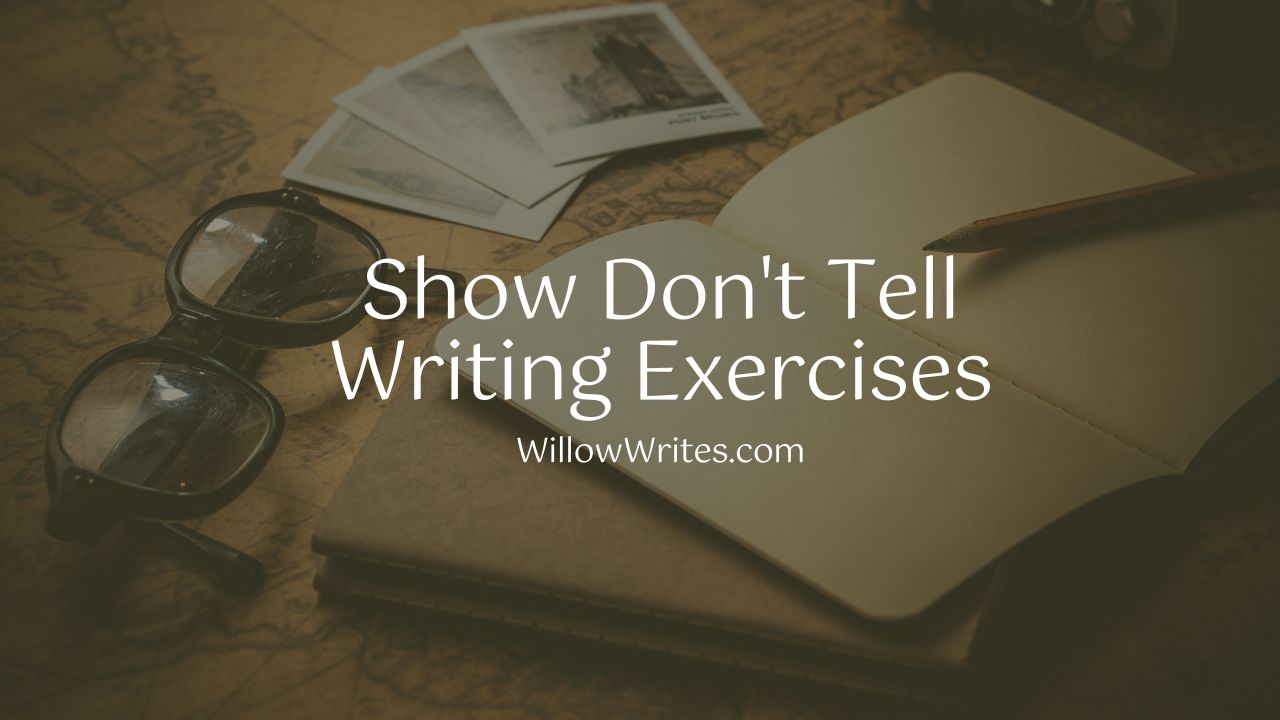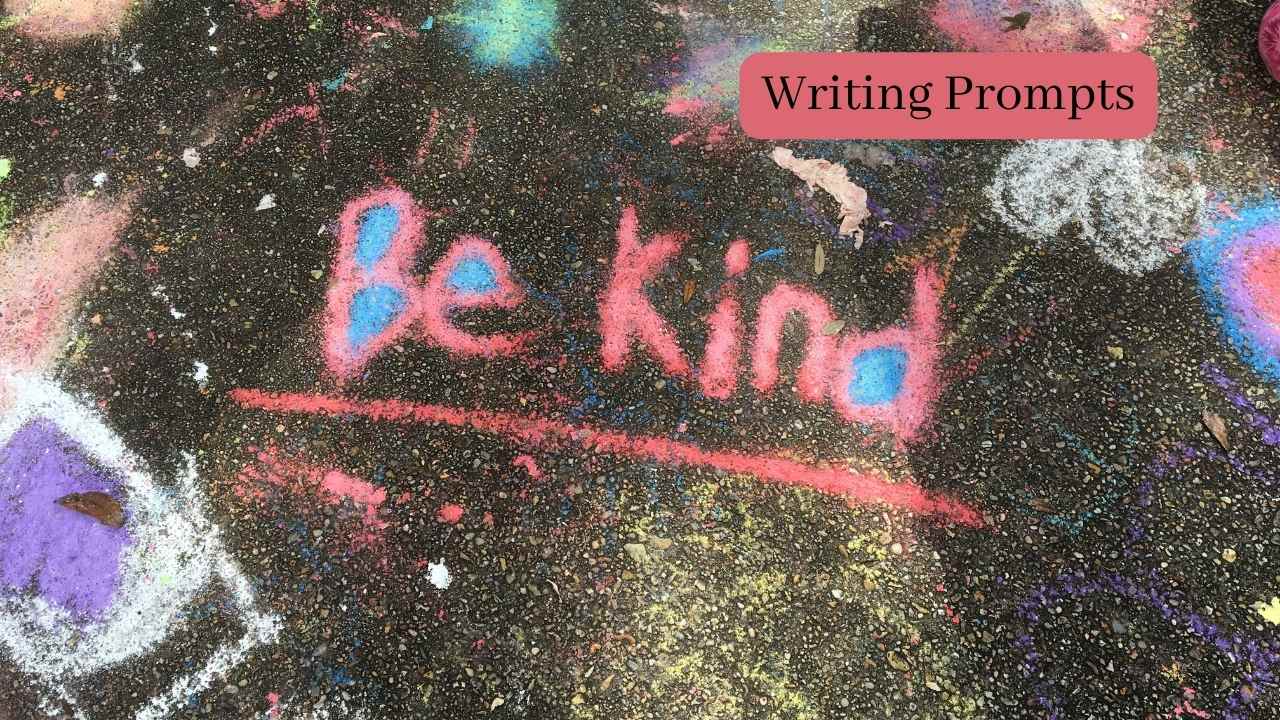Telling is easy. Showing is hard, but it’s worth it. It’s the difference between a good story and a great one. A show-don’t-tell exercise can help you hone your skills and become a better storyteller. Show don’t tell writing exercises like these are a great way to improve your writing, and they’re also fun! So let’s get started.
What does it mean to Show Don’t Tell?
Showing vs. Telling is a common distinction in writing. Showing is when the author uses concrete details and sensory language to describe what’s happening. This lets the readers experience the story as if they’re right in the middle.
Telling, on the other hand, relies on generalizations and summaries. This can make the story feel flat and lifeless. To show is to engage all the senses and immerse the readers in the story. It’s active rather than passive.
In descriptive writing, showing is often more effective than telling.
Concrete details are specific and can be observed, felt, heard, smelled, or tasted. They help the readers feel as if they are experiencing the story firsthand.
Sensory language engages the reader’s senses and creates vivid images. It can be concrete (e.g., “the bitter taste of coffee”) or more abstract (e.g., “the sweetness of victory”).
Boring sentences tell the readers what’s happening. Exciting sentences show the readers what’s happening.
Good writers with creative writing skills use a mix of both showing and telling, depending on what will create the most impactful or interesting reading experience.
There are various forms of showing and telling. Here are some examples:
Physical reactions
Physical is a type of show. They can help develop characters and move the story forward.
Some common examples of showing include:
-A character’s heart races as they try to avoid being seen
-Sweat drips down their forehead
-Their hands shake uncontrollably
By contrast, telling would simply state that the character is scared or nervous.
Dialogue
Dialogue is another great way to show instead of telling. It can reveal a lot about a character, their thoughts, and their feelings.
For example, let’s say two friends are talking about a third friend going through a tough time.
Telling: “I feel so bad for her. She’s going through a lot right now.”
Showing: “I can’t believe she has to go through all this. It just doesn’t seem fair.”
The first example is telling because it’s summarizing the situation. The second example is showing because it gives us a glimpse into the speaker’s thoughts and feelings.
Inner thoughts and feelings
Showing a character’s thoughts and feelings can be a great way to give the readers insight into their inner world, creating a more interesting story.
For example, let’s say a character is thinking about an ex-lover.
Telling: “She was thinking about her ex and how much she still loved him.”
Showing: “She couldn’t help but wonder if he still thought about her too. She missed him so much.”
The first example is telling because it states what the character is thinking. The second example shows because it lets us experience the character’s thoughts and feelings.
Action beats
Action beats are a great way for writers to show what’s happening in a story. They are short, specific, and concrete words.
One idea, for example: let’s say a character is trying to open a stuck door.
Telling: “He was trying to open the door, but it was stuck.”
Showing: “He tugged at the door, but it wouldn’t budge. He tried again, putting all his weight into it. Finally, it gave way, and he fell into the room.”
The first example is telling because it tells us what the character is doing. The second example shows because we can see the character’s efforts in the strong verbs and feel their frustration.
Regarding writing, showing skills are often more effective than telling. It’s more interesting, engaging, and immersive. So next time you’re writing, try to use concrete details, sensory language, dialogue, action beats, and inner thoughts and feelings to show instead of tell.
Body Language
When writing, it is important to use this format to help show what is happening in the story. This will make your writing more interesting and help people understand what is happening. You can do this by using good descriptions of what people are doing and how they feel.
In this blog post, the writer describes a situation with her best friend. In this example, she uses a ‘showing versus telling’ writing style by incorporating body language. This helps in describing her best friend’s actions which helps readers understand the situation.
My best friend, Sarah, was having a terrible day. She was exhausted from work and just wanted to go home and relax. But when she got home, her kids were screaming, and her husband was nowhere to be found.
Sarah was so frustrated that she started to scream and yell at her kids. She couldn’t control the shaking of her body or the tears streaming down her face caused by the overwhelming stress. Her kids were terrified, and they started to cry. It was a complete disaster.
This short story would be much less effective if the writer had simply ‘told’ us what was happening. By showing Sarah’s physical reaction and emotion, we can feel her stress and understand the situation better.
Good descriptions can help make your writing more interesting and believable. The emotions manifesting in the characters’ movements should be consistent with what they say and think. This way, you can give your readers a richer experience and help them understand your characters better.
Here are some more examples of how to incorporate body language to show emotion into your writing:
1. His heart was pounding so hard, that he thought it might
Creative Writing Exercise:
1. Write a short paragraph with a description of someone angry. Include as much detail about their body language as you can.
2. Write a short paragraph with a description of someone who is in love. Include as many details about their body language as you can.
3. Write a short paragraph about someone who is
What are Show Don’t Tell Writing Exercises?
Show, don’t tell exercises can be done with any type of writing, but they are especially helpful for fiction. You will need a piece of paper and a pencil for these exercises. You can also use a word processor if you prefer. Choose a scene or event from your life, or make one up. Once you have your scene, it’s time to start writing.
Telling:
The sun was setting.
Showing:
The sky was ablaze with oranges and pinks as the sun slowly dipped below the horizon.
Can you see the difference? The first sentence is telling, while the second sentence is showing. The first sentence tells the readers what is happening, while the second shows what is happening. Showing is always better than telling. It allows the readers to experience the story rather than just being told about it.
Show vs. Telling Examples
Telling:
John was angry.
Showing:
John’s face turned red, and he clenched his fists as he shouted at the top of his lungs.
Telling:
The food was gross.
Showing:
I gagged as I tried to force down the slimy green concoction that was supposed to be dinner.
Telling:
She was scared.
Showing:
Her heart was pounding so hard she thought it might burst out of her chest. She was sweating and shaking, and she could barely breathe.
As you can see, showing, in a show don’t tell style, is always more effective than telling.
Show Don’t Tell Writing Prompts.
Here is some show don’t tell writing prompts to get you started:
1. Write a scene where two people are arguing. Show the anger and frustration without using the words angry or frustrated.
2. Write a scene where someone is trying to hide their feelings of sadness. Again, avoid using the word sad.
3. Write a scene where a character feels guilty about something they’ve done.
4. Write a scene where someone is feeling embarrassed.
5. Write a scene where a character is feeling scared.
Remember, the goal is to show emotions without using emotionally charged words. Get into the reader’s mind, and let them experience the emotions themselves.
Using Sensory Words
Create a story full of vivid details when you write. This will help people understand what is happening without having to be told. For example, if you are writing about a person walking, you could say that their feet felt heavy as they walked through the wet grass. This gives the reader a better idea of what is happening than if you just said that the person was walking.
The best words are often adjectives. They describe how things look, feel, smell, taste, and sound. Here is a list of some common sensory words:
Soft, hard, rough, smooth, slimy, bumpy
Bright, dull, sparkly, cloudy
Sticky, gooey, wet, dry
Metallic, rotten
Strong, faint
Quiet, loud
You can use these words to describe anything in your story, paying attention to how things look, feel, smell, taste, and sound. This will help create a more vivid picture for your readers.
For example, if you are writing about a character.
- He had a soft voice that was barely above a whisper.
- Her touch was rough and calloused from years of work.
- The food tasted bland and left a metallic aftertaste in his mouth.
You can also use sensory words to describe the setting of your story.
- The room was small and cramped, with bare walls covered in cracks.
- The air was thick and heavy, making it hard to breathe.
- The ground was sticky and covered in slime.
When you use sensory words, your reader can imagine the scene more clearly and feel like they are part of the story.
Exercise: Choose one of the scenes from your story and describe it using as many sensory words as possible.
- The scene I chose is when the protagonist is in a dark forest .
- The trees were tall and foreboding, their branches reaching like clawed fingers.
- The ground was uneven, littered with sharp rocks and fallen logs.
How to Make Emotions Manifest in your Writing
Describing emotions can be tricky, but getting them right is important. After all, emotions are what make short stories interesting. Without them, your story will be flat and lifeless. The money is in the details, they say. Creating emotion helps you show don’t tell for your reader.
Practice showing physical sensations that come with emotions. For example, if someone is feeling angry, they might have a tightness in their chest, their heart might be pounding, and they might be clenching their fists. If someone feels scared, they might be sweating, shaking, and have difficulty breathing.
As a writer, you can also describe the different emotions people are feeling by the expressions on their faces with details.
Some common facial expressions to include in your writing are:
Smiling, frowning, scowling, grimacing
Rolling eyes, widening eyes, narrowing eyes
Biting lip, clenching jaw
Blushing, pale
Use this writing advice to express the following emotions.
Fear: To show rather than tell fear, have your character’s heart race, their breath quicken, and their palms sweat. They might also have tunnel vision and feel dizzy.
Anger: When a character is angry, they might have a tightness in their chest and clench their fists. Their face might flush red, and their breathing might quicken.
Happiness: To show happiness, have your character smile, laugh, or their eyes might light up. They might also feel a warmth in their chest.
Sadness: When a character is sad, they might cry, their shoulders might slump, and they might have a hard time speaking.
Here is an example of how you could show rather than tell fear:
John’s heart was pounding as he walked through the dark forest. He could feel the sweat on his palms and knew he was shaking. His breathing was quick and shallow, and he felt like he would pass out. The darkness was closing in on him, and he was sure things were lurking in the shadows, watching him. He felt like he was going to die.
One adjective that could be used in writing to describe the forest is “dark.”
To avoid boring sentences and incorporate creative writing, use a vivid image and show don’t tell.
In practice, this would look like changing describing the forest from ‘dark’ to Tall, foreboding, dark, and dreary.
The trees were tall and foreboding, their branches reaching like clawed fingers. The ground was uneven, littered with sharp rocks and fallen logs. A thick fog had rolled in, making it hard to see more than a few feet in front of him.
Using Strong Verbs
One way to make your writing more interesting is to use compelling action words. These are action words that paint a picture in the reader’s mind. They make your writing more dynamic and help you avoid boring flat text.
Here’s a word list to give you an idea:
Sprint, gallop, crawl
Cry, laugh, whimper
Destroy, build, create
Stab, shoot, punch
To run: dart, dash, race, sprint, tumble
To jump: bound, leap, spring
To hit: bash, batter, smash, strike
To see: behold, glare, glimpse, spy, stare
To hear: echo, screech, grunt, yell
Remember, you want to avoid using the same words repeatedly. Mix it up to keep your writing interesting.
Now that you know some better ways to describe action words let’s see how we can use them in our writing.
The following sentence is flat and uninteresting.
She walked across the room.
This sentence is much more interesting.
She strutted across the room, her head held high.
Case in point, you can see the difference that using a strong verb makes. The first sentence is dull and uninspired. The second sentence is more creative and shows rather than tells us more about the character.
Writers often use specific descriptive actions in their short stories to create sensory images. This is because certain verbs can help readers see, taste, smell, feel, and hear what’s going on in the story.
Some examples of sensory verbs are:
See: glimpse, spy, observe, view
Taste: savor, devour, guzzle
Smell: reek, stink, fragrance
Hear: murmur, grunt, whisper, screech
Feel: smooth, prickly, slimy
When you’re using sensory verbs, it’s important to be specific for the reader. You want to create a clear image in the reader’s mind. The more specific you are, the easier it is for the reader to picture what’s happening.
The point of using sensory verbs is to help the reader feel like they are a part of the story. When done correctly, it can make for a very immersive experience.
Here’s an example of how you could use sensory verbs to describe the smell of a character’s cologne:
As he walked by, I caught a whiff of his cologne. It was a mix of musk and vanilla, with a hint of something citrusy. It was intoxicating, and I had to fight the urge to lean in and inhale deeply.
As you can see, using sensory verbs allows you to be more descriptive in your writing. This makes for a more enjoyable experience for the reader.
Here are some examples of specific and unspecific sensory verbs.
Unspecific: He looked at the object.
Specific: He glared at the object, his eyes narrowed in anger.
Unspecific: She smelled something.
Specific: She wrinkled her nose in disgust as she smelled the rotting food.
You can see that being specific makes a big difference. It’s important to choose the right verb to create the desired effect.
Creative Writing Practice:
Write a great post, fact or fiction, for a travel blog about your hometown that using your showing skills with as many strong verbs as possible.
Your interesting stories should include characters, plot, and conflict using vivid descriptions, senses, and emotions. Each sentence should bring your characters to life and make the reader feel like they are right there with them, experiencing everything firsthand.
Maybe this small town character is determined to leave their home town. This character has big dreams and aspirations, but the monotony of their small-town life constantly holds them back. They try to use their imagination to escape, but it’s not enough. One day, they finally muster up the courage to leave- but they find that the real world isn’t as forgiving as they thought it would be.
Or, another idea: the character could be content with their small-town life and love everything about it, from the slow pace to the friendly people. They have a strong sense of community and feel like they belong. When someone tries to come in and change things, they have to fight to keep their town the way they love it.
No matter what kind of stories you choose to write, make sure to use strong verbs for the reader, and show don’t tell in order to bring your characters and setting to life. Use as many senses as possible to transport your reader into your stories.
Note: There’s no wrong way to do this creative writing exercise. Use present or tense. Have fun, make a great effort, and see where your imagination takes you!








